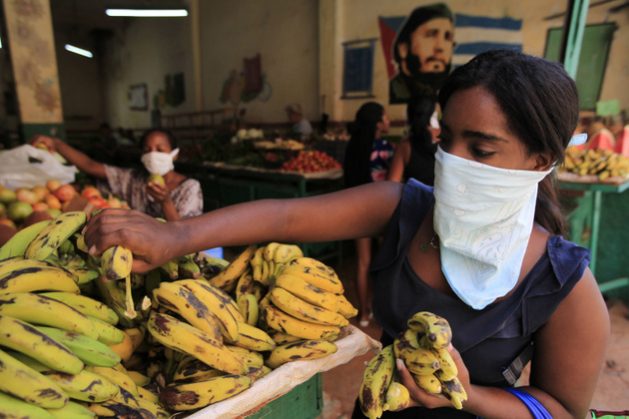Cuba’s Agricultural Sector, a Permanent Challenge
By Betsy Anaya Cruz* (IPS)

HAVANA TIMES – When it comes to development, the agricultural sector fulfills several important functions, including providing food to the population, supplying raw materials to the food processing industry, generating foreign exchange through exports, and releasing foreign currency in the form of import substitution. In addition, it is a sector that generates jobs and that allows development in the communities where it takes place.
In Cuba, attention has traditionally been focused on the sugar industry, which has been a major source of economic activity in Cuba since neocolonial times.
The country became known as an exporter of sugar and importer of other foods. First, sugar was exported to Spain, then to the United States, and later to the former Soviet Union and the rest of the socialist bloc. Regarding food imports, by the end of the 1950s they represented approximately one fifth of total imports, 47% of dietary energy, and 53% of the protein consumed in Cuba.
Between 1959 and 1989, new economic strategies were pursued that included food production as a secondary purpose. The agricultural sector was provided with more materials than the average of other Latin American and Caribbean countries, and even, in the case of fertilizers, that of North America. However, even with this stimulus, Cuban agricultural yields remained well below those of these regions.
Additionally, during this time more than 40 agricultural research centers were created, and progress was made in agro-industrial integration. However, this only occurred in a small group of products, especially the sugar industry and its export. Dependence on imports continued. In 1989, 57% of calories and 62% of protein consumed in the country came from imported food.

The crisis that ensued [with the collapse of the Soviet Union and the Socialist bloc] forced a change in the technological paradigm in the face of the sharp cut in imports. This reality uncovered many lessons from the previous period:
-Having sufficient resources does not in itself guarantee efficient agricultural production with high yields.
-External dependency makes the sector very vulnerable.
-The agricultural model based on large farms is less manageable and efficient than the one based on smaller farms.
-Centralized resource allocation management is inefficient. Every operative needs autonomy to manage their activity.
-Issues such as the production process structure, how to encourage production, and the relationship between farmers and industry are keys to the sector’s success.
-Warehousing and associated services (such as transport) are also important so that greater production results in greater consumption.
-Farmers need market space so that they can channel their production and earn additional income.
During the 1990’s, a group of important transformations were implemented, whose purpose was to increase sovereignty over our food supply.
Special development programs were designed to increase production of some commodities (such as pork). Almost two decades later, in 2007, President Raúl Castro drew attention to the inconsistency between the amount of land that lay idle and our dependence on food imports, which cost approximately two billion dollars each year (a figure that is still accurate today).
Once again, a package of measures was implemented to stimulate food production, but to date it has not shown any truly significant results.
This begs the question, what has happened to food production in Cuba? Why is it impossible for our agricultural sector to feed the population to a greater extent, despite the fact that on paper our country has always prioritized this objective? Is it a question of production problems? Is it that the soil quality does not allow increased production, for example? Is it a property ownership issue, as some authors suggest? Is it that we do not have sufficient material resources? Is the blockade keeping us from achieving this goal?
As we ponder the answers to these questions, 2020 finds us at a crossroads. As Economy Minister Alejandro Gil would say, we do not know what will happen to our imports with the worldwide coronavirus scourge. Will the producer countries continue to export? How do we maintain our rate of consumption when it is so dependent on foreign purchases?
If the transformations (the programs for which have been similar over time) have not occurred so far, it is time to implement different, more effective, and innovative alternatives, with fewer slogans and more objectivity.
What can be done to get a different result?
I propose some steps we can take. We must act quickly, even in the midst of this situation. My proposals are:
Apply scientific research findings to production; equalize management of all types (state, cooperative and private); stimulate the relationship between the different agricultural sectors (producers, warehousing, commerce, industry, and service providers); introduce pre-financing programs by industry or other areas.
Also, reduce the bureaucracy that is at the very heart of the agriculture system and invest time, energy, and resources in the production area and other key links in the chain; remove all obstacles to production; allow the formation of second-degree cooperatives for harvest collection and other activities; and above all, give flexibility and autonomy to growers (state and non-state), allowing them to help design diverse solutions to this complex and pressing problem.
*Betsy Anaya Cruz is an economist and Director of the Center for Cuban Economic Studies at the University of Havana.






Just To Inform On the Truth, As I was Quarantined in Havana with Many other from around the World Before the Last Flight Out, One Evening 3 Men Entered the Bar area of the Hotel Resort we Stayed at, I Had to ask as they sat down next to me, Where are you from. Thinking to myself they where Cuban Staff, Workers For Sure. No Migrant Workers Brought in for the tobaco, Migrant Workers Brought into Cuba with the investors Demand that Peru workers Staff there investment. NOW Tell Me Different, The Youngest was 18 & the other Men Joking Showed Me the Hands of a Man thatHad Worked fpr many years, Then they Held up the Hands of the younger Man, Baby Soft. Has Cuba LOST The Drive To Work, What Has Taken Place OR Replacement.
Ginni you are obviously well meaning and intentioned, but clearly lack knowledge of Cuban agriculture. Believe it or not Ginni, there are some modern up-to-date tractors and agricultural machinery in Cuba in addition to the fifty year old USSR stuff, horses and oxen. As an American citizen, you should understand that US policies deny the opportunity for US tractor manufacturers to sell their products in Cuba, but the US is I believe the largest single supplier of agricultural products to Cuba – including frozen chicken from Tyson and canned goods from many states. An agricultural school was established in I think 1963, when Fidel Castro engaged Dr. Reg Preston from Scotland, to develop a beef program – hence those empty beef lots scattered across the landscape. The main difficulty for Cuba’s agriculture is a combination of communist policies and incompetent management.
There WAS an effort to manufacture tractors in Cuba (technology literally older than I am, but hey, it works), but the incompetence of the Cuban government ruined it. They are making those tractors in Ukraine and Peru instead. See https://www.newsobserver.com/news/local/article211110089.html
During the two visits to CUBA over the past ten years I became well aware each time how the Cuban Farmers were ‘working with a stick and a stone’ no mechanization of any kind from one end of the Island to the other end. Here in the USA there are all kinds of tractor companies that would love to export their products to help with the agriculture prosperity. Agriculture Schools would enjoy the challenge to establish Avocados as a crop for export as well as food for all residents to acquire at the monthly food distribution. In addition, there could be other products made such as having a margarine factory providing jobs for others.
Really, this article is pretty vague.
If one were to say, “the embargo has deprived Cuba of agricultural machinery, diesel fuel, and other essential tools”, that would be a defensible argument. Unfortunately, is isn’t true. There are plenty of exportable products, such as tree fruit, that do not require mechanization.
The obvious problem with manual-labour crops is, who is willing to do this sort of work for $20 a month? Nobody, that’s who. Why would a government that preaches “power to the workers” be unwilling to pay them?
And one more specific: Cuba’s agricultural resources are tied up with producing sugar and tobacco, two products that hardly anybody wants. (That Havana Club rum that you see everywhere is actually a sugar product.) Why won’t they put these resources into something that people actually want, such as avocados?
The author works at the University of Havana. Figures.
Reduce bureaucracy ?
That would be a good place to start.
A semi-nonsensical analysis which does however pose the critical question: “Why is it impossible for our agricultural sector to feed the population to a greater extent”? The answer lies in the inability of the Cuban Communist government policies and practices which don’t merely inhibit change, but oppose it. What does “equalize management” actually mean, fire the current administration? What does “stimulate the relationship between the different agricultural sectors ” actually mean – perhaps an indication that the chaotic supply chain is in need of new management?
One has to agree however with the conclusion that: “Also reduce the bureaucracy that is at the very heart of the agriculture system” But doesn’t that, apply to virtually every aspect of the Cuban economy?
I wonder in front of this ineffectiveness of the Cuban‘s regime who they going to blame For everything in a country that the only thing than ”works” is the repression the dictatorship has someone else to blame.